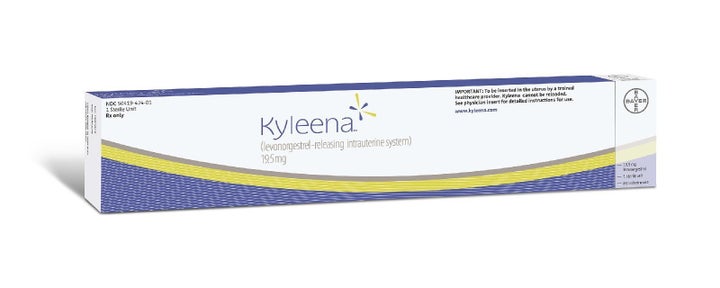
There’s a new hormonal IUD in town: Kyleena, the first device of its kind meant to offer long-lasting contraception to women who have never been pregnant.
Kyleena was approved by the U.S. Food and Drug Administration Monday and will be available in October, part of a new surge in IUD offerings in recent years: Skyla appeared in 2013 as the first FDA-approved IUD in 12 years, and Liletta was approved in 2015.
IUDs are a common form of long-acting reversible contraception, or LARCs, that last for several years. The rapid development in the IUD market ― there are now five options total ― coincides with increasing usage rates of LARCs in general: About 7.2 percent of all women of reproductive age in the U.S. used LARCs like IUDs or contraceptive implants in 2013, a five-fold increase from 1.5 percent of women in 2002.
These IUDs ― short for intrauterine devices ― are small T-shaped objects inserted into a woman’s uterus to prevent pregnancy. The hormonal devices release a small amount of levonorgestrel, a synthetic hormone that prevents the release of the egg from the ovary and fertilization of the egg by sperm. It also thins the uterine lining to prevent any embryos from implanting and becoming a pregnancy.
Kyleena joins the previously released IUDs Mirena, Skyla, Liletta and Paragard. Unlike the others, ParaGard does not release hormones to help prevent contraception. Instead, it’s made with copper, which creates a uterine environment that is toxic to sperm.
For decades, gynecologists only prescribed IUDs for women who were done having children because of concerns about a link to infertility. This fear, no longer relevant, stemmed from serious health problems caused by the Dalkon Shield, an IUD that was recalled from the market in 1980. Kyleena is distinct in that it’s the first five-year hormonal IUD on the American market that is approved for all women ― not just those who have already given birth before. Of course, FDA approval doesn’t dictate how a device is used, and other IUDs have been used by countless women who have never given birth.
And among the four hormonal IUDs, Kyleena releases the lowest dose of hormones for the longest amount of time.
How should you choose which IUD is right for you?
All the hormonal IUDs on the market have low systemic levels of levonorgestrel, according to Dr. Nikki Zite, a physician in the University of Tennessee’s department of obstetrics and gynecology. The subtle differences between each one are meant to offer women more choice about how they want to prevent pregnancy and perhaps even alter their period flow.
“Some women want the benefit of having light-to-no periods, achieved through slightly more levonorgestrel, but other women want the absolute smallest amount that will effectively prevent pregnancy,” Zite said. “By ensuring a woman has comprehensive understanding of her options and how they correspond with her personal priorities, we help women increase the likelihood of satisfaction with her contraceptive method.”
Here’s how every IUD breaks down:
Like other IUDs, Kyleena does come with rare risks. During the clinical trial to get it approved, 22 percent of the 1,452 women who received Kyleena at health centers around the world dropped out of the study because they experienced an adverse reaction. Of women who dropped out for an adverse reaction, the most common complaints were increased bleeding (4.5 percent), pelvic pain (4.2 percent), device expulsion (3.1 percent), acne (2.3 percent) and painful periods (1.3 percent).
An even smaller minority of participants experienced serious reactions like ectopic pregnancy, miscarriage, depression and uterine perforation.
Zite, who wasn’t involved in the trial, points out that these risks are in line with other IUDs on the market. In the first year of the trial, there were just two pregnancies in more than 16,000 menstrual cycles. Over the trial’s five-year run, there were just 13 pregnancies in more than 57,000 cycles.
”The absolute risk of pregnancy was very low, but of the 13 pregnancies, it looks like 10 were ectopic, which goes along with what we know,” Zite said. “If you get pregnant with an IUD in place, you are at higher risk of that pregnancy being ectopic, but again, the risk of pregnancy is very low.”
The trial also calculated that about 71 percent of the women who wanted to become pregnant after the study conceived within 12 months after their IUDs were removed. About 80 percent of women who use the Mirena IUD, the only other five-year hormonal IUD on the market, become pregnant within a year of having the device removed.
”The decision about what kind of hormonal or non-hormonal birth control to use is, and should be, made on an individual basis, in consultation with a woman’s doctor,” Kite concluded. “By ensuring a woman has comprehensive understanding of her options and how they correspond with her personal priorities, we help women increase the likelihood of satisfaction with her contraceptive method.”
Why LARCs matter
Almost half of all pregnancies in the U.S. are unplanned, and these unintended pregnancies are linked to delayed prenatal care and increased health risks for mother and child. However, these figures may decrease if more American women adopt LARCs as their primary birth control method, says Dr. Leah Millheiser, director of the female sexual medicine program at Stanford University Medical Center.
IUDs and implants are the most effective birth control methods available to women because they’re error-proof, she explained. The devices don’t require users to remember a daily medication or insert something before sex.
“LARCs are a fantastic option for women who want to be in control of their reproductive future,” Millheiser said. “Women with IUDs know their chance of getting pregnant is less than one percent.”

